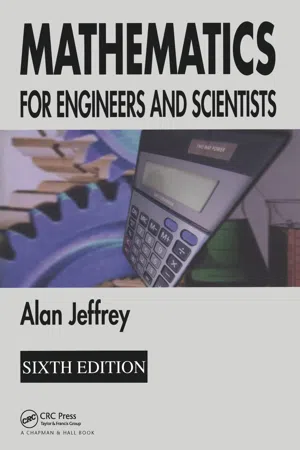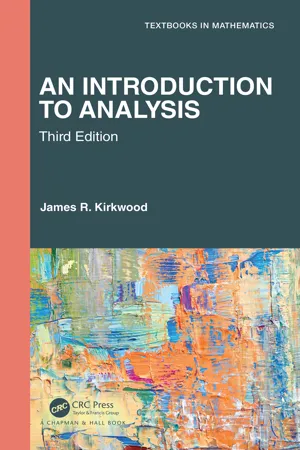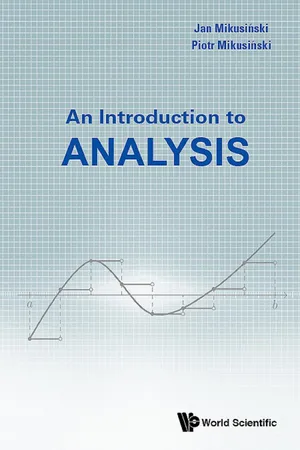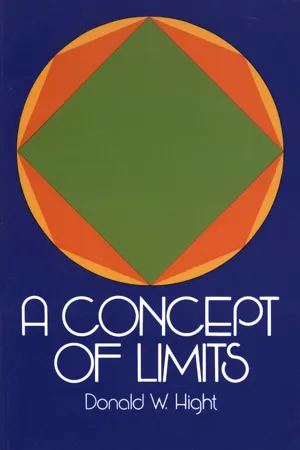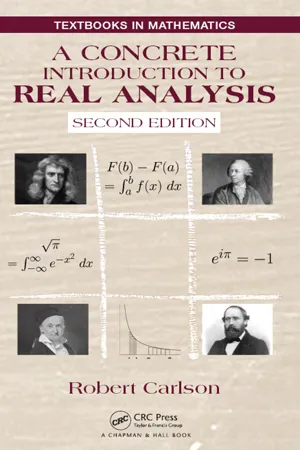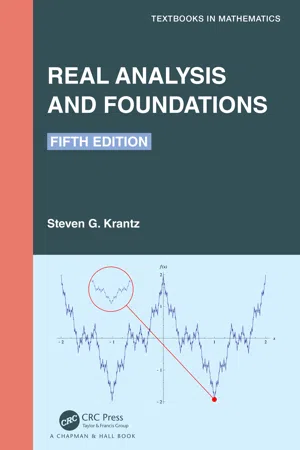Mathematics
Sequences
Sequences are ordered lists of numbers or objects that follow a specific pattern or rule. Each element in a sequence is called a term, and the position of a term in the sequence is called its index. Sequences can be finite or infinite, and they are commonly studied in mathematics and other fields for their properties and applications.
Written by Perlego with AI-assistance
Related key terms
10 Key excerpts on "Sequences"
- eBook - ePub
- Alan Jeffrey(Author)
- 2004(Publication Date)
- Chapman and Hall/CRC(Publisher)
+ … is a series.If a sequence is composed of elements or terms u belonging to some set S , then it is conventional to indicate their order by adding a numerical suffix to each term. Consecutive terms in the sequence are usually numbered sequentially, starting from unity, so that the first few terms of a sequence involving u would be denoted by u 1 , u 2 , u 3 ,… . Rather than write out a number of terms in this manner this sequence is often represented by {un}, whereunis the n th term, or general term, of the sequence. The sequence depends on the set chosen for S and the way suffixes are allocated to elements of S . A sequence will be said to be infinite or finite according to whether the number of terms it contains is infinite or finite and, unless explicitly stated, all Sequences will be assumed to be infinite. The notation for a sequence is often modified towhen only a finite number N of terms are involved, so that{u n}n = 1N.={u n}n = 1Nu 1,u 2, … ,u NAs an example of an infinite numerical sequence, let S be the set of real numbers and the rule by which suffixes are allocated be that to each integer suffix n we allocate the number 1/2n which belongs to R . We thus arrive at the finite sequence u 1 = 1/2, u 2 = 1/22 , u 3 = 1/23 - eBook - ePub
- James R. Kirkwood(Author)
- 2021(Publication Date)
- Chapman and Hall/CRC(Publisher)
2Sequences of Real Numbers
2.1 Sequences of Real Numbers
One of the great advantages of calculus is that it enables us to solve problems of a dynamic nature, that is, problems in which a change in the variables occurs. The technique that calculus uses to deal with this type of problem is the limiting process. In this chapter we introduce Sequences of real numbers. Sequences provide perhaps the simplest setting for the rigorous study of limits, and Sequences will also be indispensable in studying more complex topics.Definition: A sequence of real numbers is a function from the positive integers into the real numbers.The function concept is not the most convenient way to visualize a sequence, and we shall establish a more intuitive viewpoint. If f is the function in the definition, then the range of f is the set{ f ( 1 ) , f ( 2 ) , … } .The numbersf ( 1 ) , f ( 2 ) , …are called the terms of the sequence andf ( n )is called the nth term of the sequence. The domain of a sequence is always the positive integers. Therefore if we list only the range or terms of the sequence in their natural order of appearance, then the sequence will be completely described. It is customary to further simplify the notation and write fnforf ( n ). So now our sequence is written as a subscripted variable within braces{or more often asf 1,f 2, … }{. Thusf n}{will represent a sequence whose first term is x1 , whose second term is x2 , and so on.x n}Sequences are often viewed as an infinite string of numbers. Two Sequences are equal if and only if they are equal term by term. That is, not only must the numbers in the Sequences be the same, but they must also appear in the same order. Thus the sequence{ 1 , 2 , 3 , 4 , 5 , … }is not equal to the sequence{ 2 , 1 , 3 , 4 , 5 , … }even though they consist of the same numbers.Often a sequence is represented by a function within braces, which describes the nth term of the sequence. For example, we might represent the sequence{ 1 , 1 / 2 , 1 / 3 , 1 / 4 , … }as{ 1 / n }, since the nth term of the sequence is equal to1 / n - eBook - ePub
- Joseph D. Fehribach(Author)
- 2023(Publication Date)
- De Gruyter(Publisher)
1 Sequences in ℝOur discussion begins with a very basic concept in mathematics: Sequences. Probably most people have at least a general intuitive idea of what a sequence is. One simple example of a sequence iswhile another more irregular sequence is{ 1 , 2 , 3 , 4 , 5 , … } ,{ 3 , 7 , π , 2 / 5 , − 6 , … } .In the second case, it is not possible to predict what the next entry will be after −6, but nonetheless, both examples seem to satisfy the essential sense of what a sequence is. What is needed now is an exact mathematical definition:Definition.
A sequence is a functiona : A → Rwhere eitherA =orZ +: = { 1 , 2 , 3 , … }A = N : = { 0 , 1 , 2 , 3 , … }(the natural numbers) or perhaps A is any countable set.1 Thus, eitherora : {a n} = {a 1,a 2,a 3, … }a : {a n} = {a 0,a 1,a 2,a 3, … } ,where in both cases. We refer toa n∈ Ra nas the n-th element or entry of the sequence.Remarks.
1.2.Notice that a sequence differs from a set in that a sequence has an order, whereas a set is simply a collection of elements. Technically, there is no first element in a set, but there is in a sequence.3.This is not the most general definition of the word “sequence,” but it is easily general enough for our purposes. It contains all the key ideas to discuss Sequences. In particular, we will not discuss finite Sequences.Notice that for our purposes, Sequences begin either withn = 0or withn = 1. Beginning with a zeroth element is less common, but it occurs sometimes when a zeroth element makes sense. Among other places, this happens in computer science. Still, unless there is some specific reason to do otherwise, letA =.Z +A sequence can be depicted graphically on the real line as in Figure 1.1 .Figure 1.1 - eBook - ePub
- Piotr Mikusi?????ski, Jan Mikusi?????ski;;;(Authors)
- 2017(Publication Date)
- WSPC(Publisher)
Chapter 5
Sequences AND SERIES
5.1Convergent Sequences
By a sequence we mean a progression of numbers a1 , a2 , . . . . While the word sequence is used to mean both finite and infinite Sequences, we will use it exclusively to mean infinite Sequences.Formally, a sequence a1 , a2 , . . . is a function defined on the set of all natural numbers. The value of that function at n is called the n-th term of the sequence and is denoted by an . We will write “a sequence a1 , a2 , . . . ” or “a sequence (an )”. The parentheses are used to distinguish the sequence (an ) from its n-th term an .Definition 5.1.1. We say that a is the limit of a sequence (an ), if for every > 0 there is a number M such that |an − a| < for all n > M. If a is the limit of (an ), we say that (an ) converges or tends to a and we writeIf a sequence has a limit, it is called a convergent sequence. Sequences which are not convergent are called divergent.While we are not requiring the number M in the above definition to be a natural number, it is often convenient to assume that it is, as in the proof of Theorem 5.1.3. Clearly, this does not result in any loss of generality.Note that the above definition is very similar to the definition of the limit of a function at infinity. As we will see, this similarity can be used to obtain properties of limits of Sequences from similar properties of limits of functions.A sequence whose terms are all equal is called a constant sequence. It is easy to see that the constant sequence a, a, a, . . . converges to a.Example 5.1.2. We will show thatLet be an arbitrary positive number. Define Then, for all n > M, we haveSince this works for any > 0, we have shown thatA sequence (an ) is called bounded if there exists a constant B such that |an | ≤ B for all n ∈ N .Theorem 5.1.3. Convergent Sequences are bounded.Proof. Let (an ) be a convergent sequence. If a is the limit of (an ), then there exists a natural number M such that |an − a| < 1 for all n > M . Hence, for all n > M - eBook - ePub
- Donald W. Hight(Author)
- 2012(Publication Date)
- Dover Publications(Publisher)
1Sequences and Their LimitsThis book is intended to be read with a pencil in hand. It is not designed .to be read as a story, for unless you knew in advance about limits you would soon be confused and lost. Many examples are given which you should analyze and classify. Questions are asked which you are to ponder and answer for yourself. It will then be possible (let us hope) for you to anticipate subsequent considerations and eventually to grasp for yourself a limit concept and to obtain for yourself acceptable definitions of limits. Now, if you have not already done so, get a pencil in hand and a pad of paper beside your book so that we may start our explorations.1–1 Infinite SequencesYou already have some idea of what a sequence is, for the word is common. In referring to a sequence of events you want to communicate that one event happened, then the next, and the next, and so forth. We wish to define an infinite numerical sequence in a similar but more specific manner. To specify that there is a first event and then a next event and a next, and so forth, we utilize the natural numbers (or the set of positive integers). The “events” that we consider are real numbers and are called terms of the sequence. An infinite sequence of real numbers is a function in which each natural number is associated with a unique real number. Since we are concerned in this text only with infinite Sequences of real numbers, we shall refer to them simply as Sequences.We shall express a sequence in a traditional manner as an ordered set or list and also as a set of ordered pairs. Thus a sequence s may be expressed either as a list or ordered set,or as a set of ordered pairs of related numbers,Here as throughout this book, we shall use the letter “n” as a symbol for a natural number. Thus, each expression for the sequence indicates that 1 is associated with s1 , 2 is associated with s2 , 3 is associated with s3 , and, in general, every natural number n is associated with a unique real number sn - eBook - ePub
- Seymour B. Elk(Author)
- 2016(Publication Date)
- Bentham Science Publishers(Publisher)
Infinite Sequences and SeriesAbstract
Up to this point in the proposed new perspective for understanding “what is calculus?” the domain associated with both integration and differentiation has mostly been confined to continuous functions. As a concluding chapter of this opus, the focus is directed to a discussion of discrete variables with an examination of the domain of Sequences and series; then a re-definition of important functions, in particular trigonometric and exponential functions, in term of infinite series, and a broad look at the concept of infinity as both a cardinal and an ordinal number. This chapter begins by defining the concept of Sequences and both the mathematical limitations and the heuristic expectations that are fundamental to a quantitative, as well as a qualitative, development of the question “is the sequence of counting numbers unending?” and the related question “if there is such a “last” number, to which the name “infinity” has been given, what are its properties?” In the preceding chapters one observed that infinite concepts applied not only to being “infinitely large”, but also to being “infinitely small”. To this latter category the term “infinitesimal” was applied. In this chapter, the further concept, referred to as different “orders” of infinity, will be encountered. Emphasis will be placed on a concept that this author prefers to associate with the heuristic of being “infinitely dense”, in contradistinction to one of being “infinitely large”.7.1. INTRODUCTION TO Sequences
After a superficial introduction in Section 1.1, the attention of this treatise has been focused almost exclusively on functions in a space which have the property that between any two points there is always another point. This has led to development in that mathematical field which has the heuristic concept of “continuity”, along with the further concept of differentiability. In this chapter the initial focus will be on a domain in which the functions are discrete, rather than continuous. For such a field a different concept of infinity will be involved. - eBook - ePub
- J. H. Curtiss(Author)
- 2021(Publication Date)
- CRC Press(Publisher)
2Sequences and Series2.1 Basic DefinitionsLet X be a nonempty set. A sequence in X (or from X) is a function from the set Z of real integers into X with domain of the form {k: k > n} or {k: k < n}or {k: m < k < n}, where m, n, k denote real integers. In the last case, the sequence is called a finite sequence. The ordering in Z automatically induces an ordering on the values of the sequence. Thus, a finite sequence with, say, N values is an ordered N-tuple.In specifying a sequence by its values, it is customary to use a subscript notation such as. If the intended domain is N = {k: k = 0, 1, 2, . . .}, we abbreviate the notation to ⟨xk ⟩. This notation is used in the case of other domains when no confusion results. When the pattern is clear, a sequence is often informally specified by writing down the first few terms; thus, x0 , x1 , x2 ,.... We indicate the range of the sequence ⟨xk ⟩ by {xk }, with appropriate elaboration if the exact domain of the sequence must be emphasized. The range of a sequence is sometimes called the trace.〈x k〉k = n∞A subsequence of〈is a sequence of the form ⟨xϕ ( k ) ⟩, where ϕ is a function from [n, ∞) into [n, ∞) satisfying ϕ(h) < ϕ(k), h < k.x k〉 n ∞If X is a field, it is consistent with the definitions in Sec. 1.7 to define the sum of two Sequences ⟨xk ⟩, ⟨yk ⟩ written ⟨xk ⟩ + ⟨yk ⟩, by ⟨xk + yk ⟩. The product ⟨xk ⟩ · ⟨yk ⟩ is defined by ⟨xk · yk ⟩ and if yk ≠ 0, k = 0, 1, 2, . . ., the quotient ⟨xk ⟩/⟨yk ⟩ is defined by ⟨xk /yk ⟩.The spaces X in which the Sequences in this book lie are C, R, and certain spaces of complex-valued functions.2.2 Metric SpacesThe concept of convergence and divergence is central in the theory of Sequences. It can be treated at various levels of abstraction, but since we specialize in Sequences in the spaces mentioned previously, an appropriate general setting for the basic definitions is given by the concept of a metric space. - eBook - ePub
- Robert Carlson(Author)
- 2017(Publication Date)
- CRC Press(Publisher)
a discussion of infinite Sequences is needed. Until the description is completed a number will be an element of an Archimedean ordered field.Intuitively, an infinite sequence is simply an infinite list of numbers. The k–th term of the sequence is denoted ck or c(k). Examples include the Sequencesand1 ,1 2,1 3,1 4, …c k=1 k, k = 1 , 2 , 3 , … ,1 , − 1 , 1 , − 1 , … ,c k=, k = 0 , 1 , 2 , … ,(k− 1)3,3 .1, 3 .14,3 .141, 3 .1415, … ,where ck is the first k digits of the decimal expansion of π.In the usual mathematical language, an infinite sequence, or simply a sequence, is a function c whose domain is the set ℕ of positive integers 1, 2, 3,…. The value c(k), or more commonly ck , of the function at k is called the k – th term of the sequence. For our purposes the values c(k) will typically be numbers, although the idea extends to more complex objects. A slight extension of the idea allows the domain to be the set of nonnegative integers.Although a sequence is a function, it is common to use a special notation for Sequences. As noted above, the terms are often written ck instead of c(k). The sequence itself is denoted {ck }. As an abbreviation, people often write “the sequence ck ,” instead of “the sequence {ck },” although this can create some confusion between the entire sequence and its k-th term.The notion of a limit is the most important idea connected with Sequences. Say that the sequence of numbers {ck } has the number L as a limit if for any ϵ > 0 there is an integer N such that|< ϵ , whenever k ≥ N .|c k− LTo emphasize the dependence of N on ϵ we may write Nϵ or N(ϵ). In mathematical shorthand the existence of a limit is written aslimk → ∞c k= L .An equivalent statement is that the sequence {ck } converges to L. This definition has a graphical interpretation which illustrates the utility of the function interpretation of a sequence. The statement that the sequence has the limit L is the same as saying that the graph of the function c(k) has a horizontal asymptote y = L, as shown in Figure 2.1 (where L - eBook - ePub
- Richard Johnsonbaugh, W.E. Pfaffenberger(Authors)
- 2012(Publication Date)
- Dover Publications(Publisher)
IVSequences of Real NumbersAnalysis is concerned in one form or another with limits. We begin our study of real analysis with the study of limits of real Sequences.10. Limit of a Sequence
Let X be a set. A sequence of elements of X is a “list” of elements from the set X. In this chapter we will be concerned with Sequences of real numbers. We first make the notion of sequence precise.Definition 10.1 Let X be a set. A sequence of elements of X is a function from the set of positive integers into X.In particular, a real sequence (or sequence of real numbers) is a function from P into R. The usual notation for a real sequence is , where a denotes the function from P into R and anis the value of the function at the positive integer n. The notations a1 , a2 , . . . and {an} are also used to denote a real sequence. The number anis called the nth term of the sequence .A sequence may be defined by giving an explicit formula for the nth term. For example, the formuladefines the sequence whose value at the positive integer n is 1/n. The first three terms of this sequence areA sequence may also be defined inductively. Thus equations define the sequence whose first six terms areConsider the sequence whose nth term is defined by the formulaThe first four terms of this sequence areThe terms corresponding to n = 100, 101, 102 arewhich are close to 1. For example, differs from 1 by only . It is clear that n/(n + 1) is “close to” 1 “for all large positive integers n.” For this reason we say that the sequence has limit 1. In general, we say that a sequence has limit L if anis “close to” L “for all large positive integers n.” To define the limit of a sequence, we need to make the concepts “close to” and “for all large positive integers n” precise.Since an− L is the distance between anand L, we would agree that anis “close to” L if an− L is small. How small? Given any positive number (no matter how small) we wish to make an− L < for all large positive integers n. If we can do this, we can make ananclose to L as we wish simply by making small enough. “For all large positive integers n” means “for all n greater than (or equal to) some fixed positive integer N.” Thus the condition we are seeking is that if > 0, there exists a positive integer N such that an− L < , for all n N. The positive integer N may depend on the which we are given. We would expect that as is taken smaller, we would have to choose N - eBook - ePub
- Steven G. Krantz(Author)
- 2022(Publication Date)
- Chapman and Hall/CRC(Publisher)
2 SequencesDOI: 10.1201/9781003222682-32.1 Convergence of Sequences
A sequence of real numbers is a functionφ : ℕ → ℝ. We often write the sequence as φ(1), φ(2), … or, more simply, as φ1 , φ2 , …. A sequence of complex numbers is defined similarly, with ℝ replaced by ℂ .The most important question about a sequence is whether it converges. We define this notion as follows.Example 2.1: The function φ(j) = 1/j is a sequence of real numbers. We will often write such a sequence as φj= 1/j or as {1, 1/2, 1/3, …} or as. The function ψ(j) = cos j + i sin j is a sequence of complex numbers.{1 / j}j = 1∞Do not be misled into thinking that a sequence must form a pattern, or be given by a formula. Obviously the ones which are given by formulas are easy to write down, but they are not typical. For example, the coefficients in the decimal expansion of π, {3, 1, 4, 1, 5, 9, 2, 6, 5, …}, fit our definition of sequence—but they are not given by any obvious pattern. □Definition 2.2: A sequence {aj} of real (resp. complex) numbers is said to converge to a real (resp. complex) number α if, for eachϵ > 0, there is an integer N > 0 such that, if j > N, then. We call α the limit of the sequence {a|< ϵ|a j− αj}. We write limj→∞aj= α. We also sometimes write aj→ α.If a sequence {aj} does not converge then we frequently say that it diverges.Example 2.3: Let aj= 1/j, j = 1, 2, …. Then the sequence converges to 0. For letϵ > 0. Choose N to be the next integer after1 / ϵ(we use here the Archimedean principle). If j > N thenproving the claim.|=|a j− 0|=a j|1 j<1 N< ϵ ,Let bj= (−1)j, j = 1, 2, …. Then the sequence does not converge. To prove this assertion, suppose to the contrary that it does. Suppose that the sequence converges to a number α. Letϵ = 1 / 2. By definition of convergence, there is an integer N > 0 such that, if j > N, then. For such j|< ϵ = 1 / 2|b j− α
Index pages curate the most relevant extracts from our library of academic textbooks. They’ve been created using an in-house natural language model (NLM), each adding context and meaning to key research topics.
